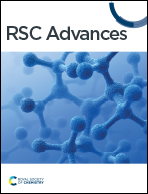Highly efficient removal of Sr2+ from aqueous solutions using a polyacrylic acid/crown-ether/graphene oxide hydrogel composite
Abstract
With the development of nuclear power, efficiently treating nuclear wastes generated during operation has attracted extensive attention. Hydrogels are common adsorbent materials in the treatment of wastewater due to their high swelling rate and easy post-treatment. In this work, a novel polyacrylic acid/crown-ether/graphene oxide (PAA/DB18C6/GO) hydrogel composite was synthesized by a radical cross-linking copolymerization method and characterized using various analytical tools such as SEM, FT-IR, TGA and XPS. The effects of time, pH, initial Sr2+ concentration, and temperature on Sr2+ adsorption onto the PAA/DB18C6/GO were studied. The PAA/DB18C6/GO shows a high adsorption capacity of 379.35 mg g−1 at an initial Sr2+ concentration of 772 mg L−1 due to the unique structure of dibenzo-18-crown-ether-6 and high swelling. The composite has a high selectivity for Sr2+ with a removal rate of 82.4% when concentrations of Na+ and K+ were 10 times higher than that of Sr2+. The pH and temperature have no apparent impact on adsorption performance of the PAA/DB18C6/GO under the experimental conditions. The composite shows excellent reusability with more than 92% removal rate for Sr2+ after five continuous cycles. In addition, the mechanism of Sr2+ adsorption by PAA/DB18C6/GO was analyzed by fitting the adsorption data to the theoretical models and XPS data.



 Please wait while we load your content...
Please wait while we load your content...